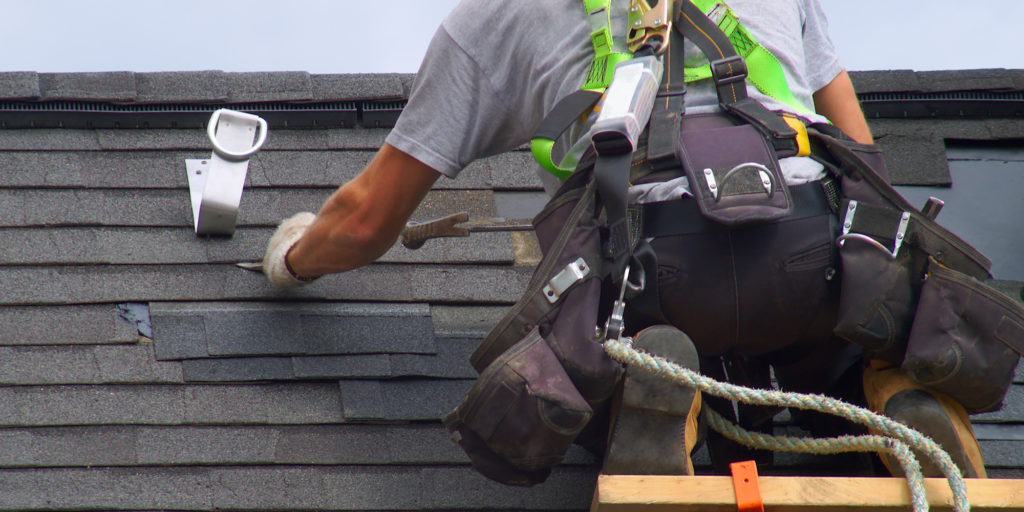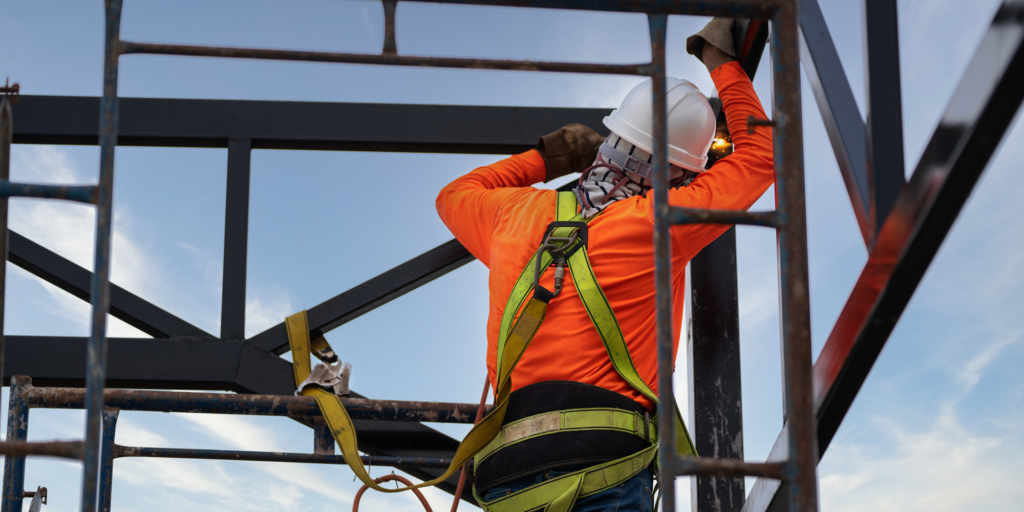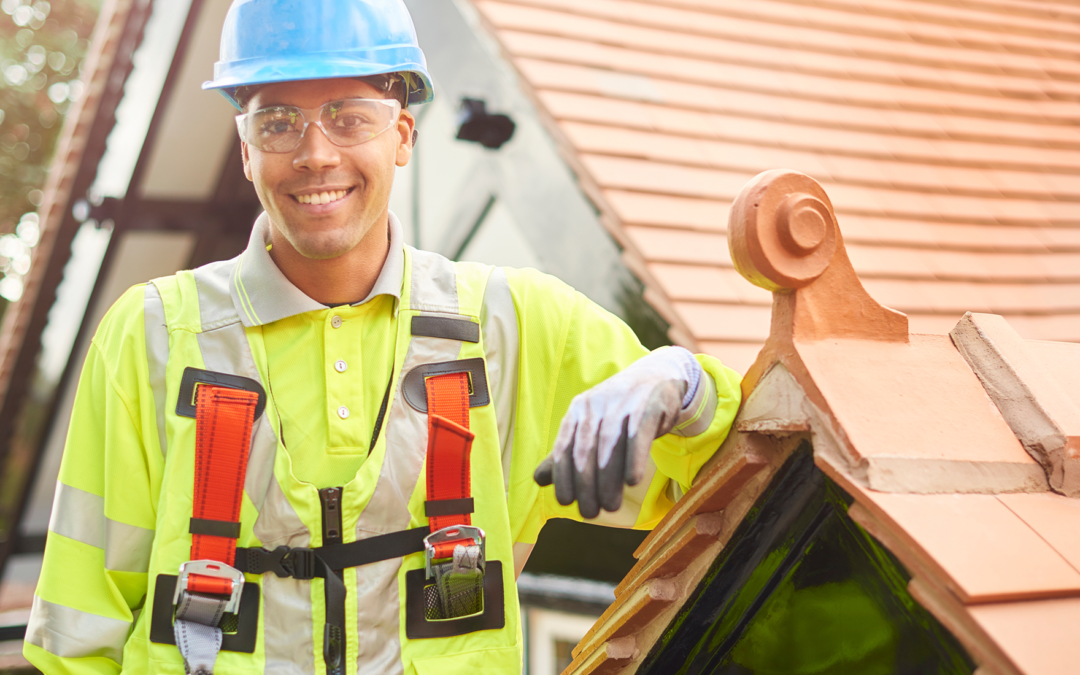Roofers face many risks but also enjoy a wonderful career. One mistake or quick break in focus might cause a catastrophic fall with dire consequences. Fall prevention for roofers is essential. Whether you’re a roofing veteran or a newbie, safety should always come first.
We’ll discuss roofer-specific active and passive fall protection innovations. We’ll discuss their features and benefits and present case studies of firms that have used these cutting-edge technologies. We’ll also cover crucial legislation and standards every roofer must know for safety and compliance.
Types of Fall Protection Systems
Active and passive fall protection devices safeguard roofing workers from falls. Each variety offers unique features and benefits to keep workers safe at heights.
Active fall protection systems prevent falls using PPE. Harnesses, lifelines, and anchor points help workers navigate roofs safely. For efficacy, these systems need worker participation and frequent monitoring.
In contrast, passive fall protection systems are hands-free and do not require worker participation. Guardrails, safety nets, and caution lines. These technologies physically protect workers from fall hazards without individual intervention.

Both active and passive fall protection have benefits. Active systems allow workers to move about a roof. Passive systems provide continual protection without human mistake or compliance.
Roofing companies must thoroughly assess their demands before picking a system. Some choose a mix of active and passive solutions, depending on their profession.
Fall protection technology advances active and passive solutions. New materials improve durability and comfort for workers using harnesses or helmets.
Some fall protection equipment now uses smart technology to track worker movements and alert them of risky conditions.
As workplace safety rules tighten, roofing companies must prioritize comprehensive training for employees employing these new technologies and regular equipment inspections.
Active Fall Protection: Features and Benefits
For roofers’ safety, active fall protection measures are essential. These technologies actively prevent falls, protecting workers at height in real-time.
A crucial element of active fall prevention is its capacity to recognize risks and respond rapidly. Some systems use advanced sensors to detect worker movements or positions. These devices can automatically activate lifelines or harnesses to avoid falls.
Versatility is another benefit of active fall protection. These systems can be tailored to roofing conditions and jobs. Active fall protection technologies are provided for flat, sloped, and industrial roofs with complicated structures.
Investing in active fall prevention shows a commitment to worker safety, which boosts corporate reputation and attracts competent workers who value workplace safety.
Passive Fall Protection: Features and Benefits
Passive fall protection solutions are essential for roofers. Passive fall protection operates discreetly in the background, protecting workers without their intervention.
Simplification is a hallmark of passive fall protection. Installation and maintenance are simple, making these systems cost-effective for contractors and building owners. Guardrails, safety netting, and anchor points prevent falls.
Other benefits of passive fall protection devices include reliability. They provide 24/7 coverage without human intervention or device failure once properly placed. This lets workers concentrate without worrying about overhead threats.
Design and application flexibility are also available with passive fall protection. There are solutions for diverse roofing situations and needs, from permanent installations to temporary setups for projects or maintenance.
Due to their lack of movement or workflow restrictions, these systems have no impact on productivity. Guardrails and lifelines allow rooftop workers to move freely.
Passive fall protection creates a safe workplace with no effort, providing long-term peace of mind. These devices protect roofers against falls at heights due to their ease of installation and maintenance and consistent functioning.
New Innovations in Active and Passive Fall Protection
Falling is a major risk in roofing, which is physically demanding. Keeping roofers safe and preventing job site accidents requires fall protection systems.
Recent advancements in active and passive fall protection systems are fascinating. Harnesses and lanyards are active fall protection. These systems give instant support after a fall, preventing major injury or death.
Passive fall protection uses engineering controls and structures to reduce fall risk without user intervention. Guardrails, safety netting, and roof or building anchor points are included.
Modern self-retracting lifelines (SRLs) have improved shock absorbers for smoother pauses and lower fall impact forces. These lightweight, durable SRLs are more comfortable for workers to wear during shifts.
Passive fall prevention has also improved. Some firms offer customisable guardrail systems that meet OSHA regulations and may be put on different roof designs. Advanced safety net designs are more durable and easy to install.
Technology integration into active and passive systems is interesting. Smart harnesses with sensors can detect falls by monitoring body posture or motions. Digital monitoring devices can track usage to ensure safety rules are followed.
These advances improve roofers’ safety, comfort, and productivity on the job. Roofing firms may show their dedication to employee well-being and stay ahead in a competitive sector by investing in these cutting-edge technologies.
Importance of Training and Proper Equipment Use
Roofers must be properly trained and equipped for fall safety. Without proper training, workers risk significant injury or death. Investing in thorough training programs is crucial.
Training should cover fall dangers, PPE use, and roof safety. Employers may empower workers to make safe decisions by giving this information.
Companies can promote safety by emphasizing training and equipment use and teaching personnel to follow protocols. This reduces workplace accidents and protects workers and a company’s reputation.
Long-term worker safety benefits from comprehensive training and equipment use enforcement. Prioritizing these components shows employers’ commitment to worker safety and fall protection compliance.
Cost Comparison between Active and Passive Fall Protection
Roofers might choose between active and passive fall safety devices. Each has various features and benefits, but cost typically comes into play. Active and passive fall protection cost comparisons can assist roofing companies choose the right technology.
PPE like harnesses, lanyards, and lifelines are used in active fall protection systems. These systems need frequent maintenance and inspections to work effectively. The initial investment in PPE may be more than passive systems.
Passive fall protection systems use guardrails, safety nets, and anchor points built into a structure. These cost more to build or convert, but they require less maintenance than active systems.
Passive solutions may save maintenance and replacement expenses for harnesses and lanyards with expiration dates, but they do not eliminate the need for heights training or attention.
Regulations and Standards for Fall Protection in the Roofing Industry
Safety should always be a priority, especially in high-risk industries like roofing. Roofers are protected from falls and other hazards by many regulations and standards.
The OSHA Fall Protection Standard is one example. Employers must install fall safety equipment for workers over six feet. Guardrails, safety netting, personal fall arrest devices, and other protective measures are also required.

In addition to government requirements, roofing companies must follow industry standards. ANSI/ASSE A10.32-2012 covers construction fall prevention system design, installation, inspection, maintenance, and use.
These rules and requirements ensure rooftop worker safety. Employers can decrease falls and make workplaces safer by following these tips.
These regulations must be followed, but that’s not enough. Accidents can be avoided with proper fall prevention equipment training. Workers must know how to wear and inspect harnesses and secure anchor points.
Professional inspections will assist uncover fall protection system faults so they may be corrected quickly.
Follow regulatory regulations and industry best practices for fall protection in the roofing sector to keep workers safe and reduce liability for falls from heights.
Conclusion
Fall protection is crucial for roofing workers’ safety and well-being. Active and passive fall protection systems have unique characteristics that can improve worker safety. Active fall protection systems detect and prevent falls in real-time. Harnesses, lifelines, and self-retracting lanyards reduce injury and death in these revolutionary systems.
Passive fall protection systems use physical obstacles to prevent falls. Passive fall protection devices like guardrails, safety nets, and roof anchors help keep rooftop workers safe.
Technology and design continue to create new active and passive fall safety technologies. Wearable gadgets with sensors to track worker movements and lightweight guardrail systems promise to increase worker safety without reducing productivity.
Even with modern fall prevention technology, sufficient training is necessary for its use. Harnesses must be correctly worn, equipment checked for damage or wear, and fall emergency protocols taught to workers.
Active and passive fall protection costs vary based on installation and maintenance. Active systems may require more initial investment owing to their complex technology, but some companies say that long-term expenditures are lower than passive system upkeep.

